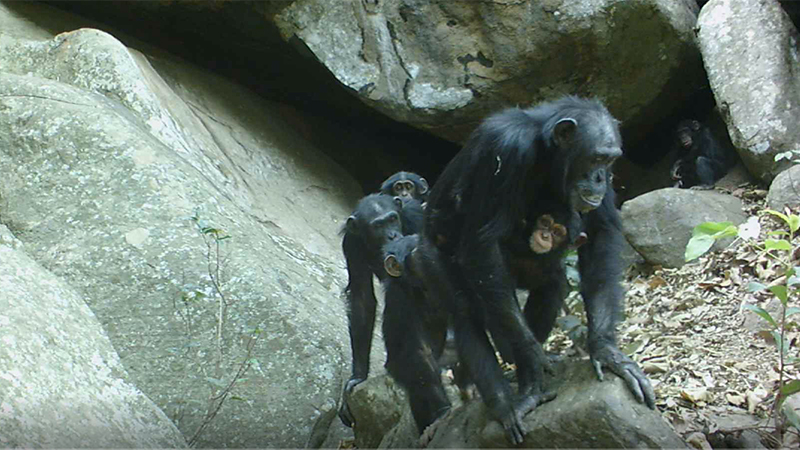September 21, 2021
Savannas challenge preconceived notions of chimpanzee behavior

Savanna chimpanzees using a cave in Sabe, Guinea. New research reviewed the characteristics of these chimpanzees – and their environments – to understand how they thrive while lacking many of the biological and cultural traits that humans possess. (Photo provided/Jane Goodall Institute Spain and Senegal)
Key research finding
While humans are able to survive in arid climates, great apes need swaths of lush forest in Africa (bonobos, chimpanzees, gorillas) or Southeast Asia (orangutans) to thrive, except for some innovative savanna chimpanzees. An international team of primatologists reviewed the characteristics of these chimpanzees – and their environments – to understand how they thrive while lacking many of the biological and cultural traits that humans possess (for example, numerous sweat glands, relative hairlessness, ability to make water containers and sun hats), which mitigate the harmful consequences of extreme heat, such as dehydration and heat stroke. The team maintains that a “savanna landscape effect” explains a complex suite of behavioral and physiological responses by chimpanzees to these challenging environments. For example, there is a tendency for savanna chimpanzees to rest in caves, dig for water and be active after dark. Moreover, the analysis confirmed that chimpanzee social groups ranged across unusually large areas while maintaining group sizes that were similar to chimpanzees in forests and that low food availability is the likely cause of it. The team calls for more research on the biological and cultural underpinnings of this effect, given that many African savannas are projected to become hotter and drier in the future.
Purdue professor, title
Stacy Lindshield, assistant professor of anthropology
Lindshield is an anthropological primatologist who specializes in behavior-environment interactions in humans’ close living relatives, the chimpanzees. Her current work investigates the relationships between foraging, nutrition and the sociopolitical strategies of female chimpanzees in savanna landscapes.
Journal name Abstract is available online.
Funding
Lindshield’s research was supported by the ASPIRE program from the College of Liberal Arts at Purdue University.
Brief summary of methods
An international team of primatologists conducted a review of the literature on chimpanzees in savanna landscapes spanning from 1961 to 2020 in order to describe major research discoveries and controversies, synthesize trends in results and identify knowledge gaps.
Writer: Coby English
Media contact: Amy Patterson Neubert, apatterson@purdue.edu
Source: Stacy M. Lindshield, slindshi@purdue.edu
Note to journalists: Journalists visiting campus should follow visitor health guidelines.

